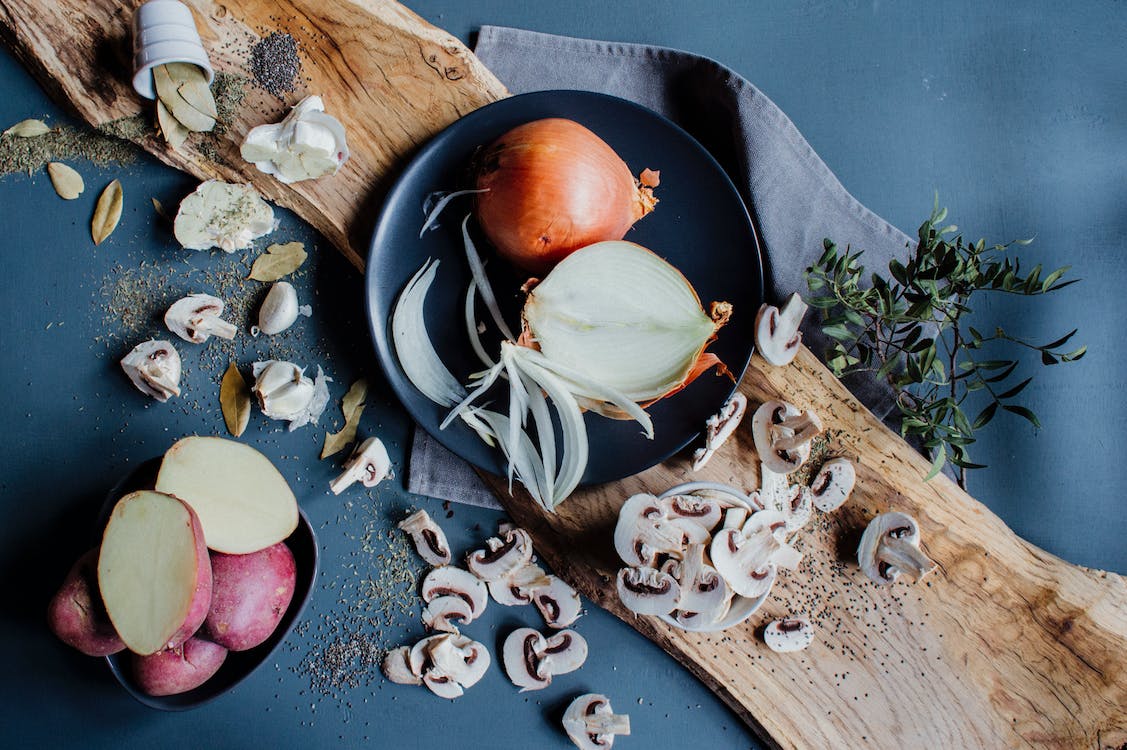The weather in September is unpredictable, unlike the list of foods that are best to buy and cook this month. To save you time, we’ve highlighted the top 5 and listed all their benefits, both health-wise and culinary-wise.
Apples
There’s no other month when apples are everywhere in such variety and at such an attractive price. This is the main season for apples: the markets and shops are flooded with garden varieties (not to mention the standard varieties such as Gala and Granny Smith), plus they’re ripening on private plots.
Apples are also the best source of homemade cakes: quiche, all kinds of pies, both open and closed, puffs, and juicy rolls. An endless field for culinary experimentation. And when bored, you can bake apples (with honey and nuts, or just like that), stuff them with meat, cereals, or mushrooms, add them to fresh salads for a nice sourness. Eating fruit fresh is also a great idea: it has been proven to help reduce diabetes risks.
An apple is one of the best snacking options
The benefits of apples
Apples of all varieties contain plenty of vitamins C, K, B group, as well as riboflavin, potassium, copper, manganese and magnesium, organic compounds, phytonutrients and flavonoids. There are so many benefits in apples that all nutritionists recommend eating at least one medium-sized fruit daily for the prevention of the most common chronic diseases. You’ll get about 12% of your daily fiber intake at the same time.
How to cook apples
Apples are used in a variety of dishes, including unsweetened ones. Although it is in baked goods that the flavor of this fruit reveals itself most richly. There are many choices of breakfast dishes with apples: muesli, apple muffins, barley porridge with baked apples and many others. Chopped apples can be caramelized in a pan with butter and sugar, then added to all kinds of cereals, cheese and pancakes as a filling. Restaurants like to experiment with the recipe for classic strudel, add apples to salmon tartar, use the dried fruit in hot dishes and in principle treat the product rather freely. But apples are up for any adventure.
Forest mushrooms
White mushrooms, aspen mushrooms, wild boletus, butter mushrooms and beech mushrooms are in their peak season. Of course, much depends on the weather. Wild mushrooms do not tolerate dryness and heat, so you will have to wait for the right time to go quietly hunting. However, shops and markets sell mushrooms on a regular basis. However, be prepared for a bitter price as they are more expensive than the mushrooms that are available all year round.
Wild mushrooms are much tastier and more aromatic than champignons.
The benefits of mushrooms
There is a lot of controversy about the benefits and harms of mushrooms. After all, they are quite a heavy meal, overloading the stomach and liver. Plus, any mushroom must be properly prepared: you need to rinse them, clean them, make sure there are no worms in them, then heat-treat them (for example, boil them).
However, we cannot say that mushrooms are just a delicacy with no benefits. According to experts, these products have a balanced ratio of proteins, fats and carbohydrates, plus a polysaccharide chitin, which, after being broken down, can reduce cholesterol levels, and also act as a sorbent and source of food for useful intestinal microflora. With gastrointestinal problems, however, eating lots of mushrooms at once is not recommended, as it can provoke an exacerbation.
How to cook mushrooms
A classic – oil-fried mushrooms with onions and potatoes. It’s almost impossible to spoil this dish. Mushrooms have a bright and incomparable taste, which is even more fully revealed in a pan. So, when you’re out of ideas, make it this way.
Mushrooms go perfectly with meat and can be baked in the same pot in the oven so that the food exchanges flavors. A more subtle art is risotto with mushrooms. Of course, you can also make this Italian dish with ordinary mushrooms, but wild mushrooms taste quite different. Cream or sour cream base whites and other noble mushrooms make a wonderful sauce that goes well with both pork and chicken. If there are too many mushrooms, they can be preserved: dried, pickled or salted for the winter.
Garlic
Experienced gardeners usually have a dried garlic crop by autumn – with proper storage, it should last until the next season. Almost any dish needs no more than a few cloves for flavor and aroma.
Garlic can be added fresh to salads (but with caution as it can aggravate chronic gastrointestinal diseases) or to baked and pan-fried dishes. The garlic does not lose its health benefits, but softens and becomes less spicy, which for many people is a big plus.
Garlic is most often used as a flavoring spice.
The benefits of garlic
Garlic in any form, but fresh garlic is more helpful in maintaining immunity and defensive functions. It is rich in vitamin C and B complex, potassium, calcium, iodine, magnesium, iron, phosphorus and other important micronutrients. It is recommended to include garlic in your diet to regulate cholesterol levels, normalize blood pressure and improve liver function. This product is not a panacea, even, as is commonly believed, during colds. But it’s definitely worth cooking it more often for variety and benefits.
How to cook garlic
Garlic is most often used as a seasoning: it is added to meat while baking, to courgette potato pancake batter, when pan-frying vegetables and to soups. The amount can be adjusted according to taste – some people like it spicier, others feel uncomfortable in the stomach because of the excess garlic. We like to bake the garlic as a whole – in the oven, with spices and oil. The garlic does not need to be completely peeled: just peel off the excess husk and cut off a small portion from the top. After roasting, the garlic transforms into a soft, fragrant paste. It can then be spread on a toasted slice of cereal bread.
Berries – sea buckthorn, cowberries, dogwood.
Autumn is the season for tart and sour berries – as useful as the earlier strawberries and strawberries. This is the time of sea buckthorn, cowberries and dogwood. Each berry has a distinctive flavor and aroma. But they can all help prepare for a long period of vitamin deficiency and virus activation. Garden and wild berries are usually abundant in vitamins C, E, A, PP and group B, iron, phosphorus, sodium, magnesium, tannins, flavonoids. Cornel Berries are recommended for diabetics, liver and kidney diseases, sea buckthorn promotes rapid healing of wounds and reduces inflammation, and cranberries are useful for vitamin deficiency, high blood pressure, and headaches.
How to cook sea buckthorn, cowberries and dogwood
The most obvious answer is to make jam for the winter. It turns out equally well from all of these berries. Another option to preserve their usefulness for a long time is to dry them. Then you can make compotes. Or add them to a brew of regular black tea. Particularly good in this regard is sea buckthorn. A mixture based on it with honey, lemon and ginger is the best remedy for colds.
Lingonberries make a nice accompaniment to meat dishes, such as oven-baked pork. They make an excellent sauce for duck or lamb, if you take a little time and play with the spices. A very interesting combination of cowberries and salmon: 300 g of thin slices of lightly salted red fish, 200 g of salad mix, 150 g of cowberries, 4 pears. Roast them in butter with sugar and curry.
The dogwood can be made into a sauce or marinated in oil as a standalone appetizer. There are also some variations of pilaf where this berry replaces barberry, plus dogwood and nuts can be stuffed into a pumpkin – and baked.
Potatoes
Potatoes are one of the easiest foods in the kitchen: easy to prepare and almost always tasty. Potatoes also keep for a long time and were a staple in the daily diet until quite recently. Nowadays, the potato is regarded with a bit of suspicion. They’re relatively high in carbohydrates, which makes them a dietary staple. For all those who think it’s important, we recommend jacket potatoes – preferably baked.
Baked potatoes retain as much of their health benefits as possible
The benefits of potatoes
If you tend to believe that potatoes are rather harmful, here’s a simple argument: Each root vegetable is rich in phosphorus, magnesium, calcium, iron, manganese, copper, zinc as well as vitamins: C, B, B2, B6, B PP, D, K, E, folic acid and carotene. Potatoes can be useful for peptic ulcers and gastritis because the starch neutralizes increased acidity in the stomach and literally envelopes its walls. Another big plus of potatoes is that they are hypoallergenic.
How to cook potatoes
In fact, however you like it best! Admittedly, if you’re a fan of lard-fried bars, you still shouldn’t indulge in this dish too often so as not to compromise on calories, carbs and fats. Other win-win options are potatoes boiled and seasoned with butter and dill, or baked in foil or pots with chunks of lean meat.
The main thing to remember is that you have to choose certain potatoes for different cooking methods. Boiling potatoes should be high in moisture and low in starch. For baking, on the other hand, dry and starchy potatoes are better. However, there is one universal advice: if you are afraid of making a mistake, take potatoes with medium values, they are suitable for all culinary experiments.

